Chapter 1: Foundations for DO-IT Practices
"My career goal is to attend community college to study criminal justice and then become a Crime Intelligence Analyst." –DO-IT Scholar
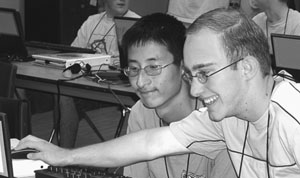
Most students have goals beyond high school, but some students find it more difficult than others to reach their goals. Students with disabilities, in particular, face unique challenges as they transition from high school to postsecondary academic and employment settings. What factors help students with disabilities secure success in academics and employment? This chapter summarizes research findings on school and employment outcomes for students with disabilities and practices that support successful transitions. It is adapted from publications that describe how DO-IT selects and applies evidence-based practices (Burgstahler, 2003a, 2006c; Burgstahler & Bellman, 2005; Kim-Rupnow & Burgstahler, 2004; DO-IT 2006a).
The number of students with disabilities pursuing postsecondary education continues to increase. However, individuals with disabilities are still less likely to enroll and succeed in postsecondary education, and they experience far less career success than their peers without disabilities. Differences in achievement between these two groups are less for those who participate in postsecondary education (Wagner & Blackorby, 1996; Yelin & Katz, 1994).
Most challenging careers, including high-tech fields in science, engineering, and computing, require a bachelor's degree or higher. Few students with disabilities, however, pursue postsecondary academic studies in these areas, and the attrition rate of those who do is high (National Science Foundation, 2000). Barriers such as inaccessible facilities, curricula, and information resources; lack of encouragement; and inadequate preparation and support persist (American Association for the Advancement of Science, 2001; Burgstahler, 2002a; National Center for Education Statistics, 2000; National Council on Disability and Social Security Administration, 2000; Schmetzke, 2001). Poor job preparation and lack of opportunities to gain work experiences also limit career options for people with disabilities (Colley & Jamieson, 1998; Unger, Wehman, Yasuda, Campbell, & Green, 2001).
DO-IT has created several video presentations and complementary publications that highlight challenges faced by students with disabilities in science and mathematics fields and tell how teachers, mentors, parents, and service providers can promote their success. They include:
- Working Together: Science Teachers and Students with Disabilities
- Equal Access: Science and Students with Sensory Impairments
- The Winning Equation: Access + Attitude = Success in Math and Science
These products can be purchased from DO-IT in DVD format or freely viewed online on the Resources page. Also available is a comprehensive set of materials titled Making Math, Science, and Technology Instruction Accessible to Students with Disabilities—A Resource for Teachers and Teacher Educators.
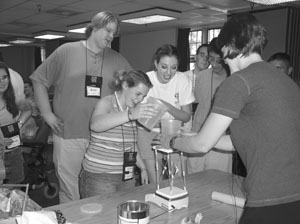
Evidence-Based Practices
Success stories of individuals with disabilities in science, technology, engineering, and other challenging fields demonstrate that barriers can be overcome and that supports can contribute to specific positive postsecondary and career outcomes. Transition activities that develop and provide opportunities to practice social, academic, career, and self-determination skills can promote success for students with disabilities (National Council on Disability and Social Security Administration, 2000). Evidence-based practices that have helped bring students from other underrepresented groups into challenging fields of study and employment include:
- access to technology
- participation in programs that bridge to higher academic levels and employment
- work-based learning experiences
- peer support
- mentoring
- hands-on experiences (Cunningham, Redmond, & Merisotis, 2003; National Science Foundation, 2005)
Transition programs with multiple components (e.g., those involving mentors, academic enrichment, and career preparation) have been found to be more effective than programs with single interventions (Cunningham, Redmond, & Merisotis, 2003).
America's Promise–The Alliance for Youth has identified five "promises" that positively correlate to young people doing better physically, psychologically, socially, educationally, and in civic engagement. They are:
- caring adults
- safe places and constructive use of time
- a healthy start and healthy development
- effective education for marketable skills and lifelong learning
- opportunities to make a difference through helping others (America's Promise, 2006)
The Search Institute reports twenty external developmental assets that have the power during critical adolescent years to influence choices young people make and help them become caring, responsible, successful adults. These external assets are described as the positive experiences young people receive from the world around them, including support, empowerment, boundaries and expectations, and constructive use of time. The Search Institute identifies important roles that families, schools, neighborhoods, and other organizations can play in promoting healthy development. It also identifies twenty internal assets—characteristics and behaviors that reflect positive internal growth and development of young people. They are grouped into four categories: positive values, positive attitude, social competencies, and commitment to learning. These internal assets help young people make thoughtful and positive choices and be better prepared for a wide variety of situations they may encounter now and in the future. (Search Institute, 2005)
"I hope to become a mechanical engineer." –DO-IT Scholar
DO-IT applies research findings from many fields of study in its Scholars program to prepare young people with disabilities for college, careers, and other adult-life experiences. It integrates activities related to self-determination, technology, mentoring and peer support, work-based learning, and college and career preparation within a comprehensive program to enhance student skills associated with positive post-school outcomes (Burgstahler, 2003a; Burgstahler & Bellman, 2005; Burgstahler, Lopez, & Bellman, 2004; Burgstahler & Orvis, 1995; Kim-Rupnow & Burgstahler, 2004).
On the next page you will find a model of critical junctures and interventions for supporting individuals through stages of postsecondary academic and career development. In the following sections key interventions used in the DO-IT Scholars program are described.
Self-Determination
The development of self-determination skills is related to positive post-school and adult outcomes for students with disabilities. Self-determination is defined as the skills, knowledge, and beliefs that enable a person to participate in goal-directed, self-regulated, autonomous behavior. Being self-determined involves understanding one's own strengths and limitations, believing in oneself, taking risks, and making informed choices (Burgstahler, 2006e; Field, Martin, Miller, Ward, & Wehmeyer, 1998).
"I want to study engineering, music, and international business when I go to college." –DO-IT Scholar
Self-advocacy is a core skill of someone who is self-determined. Self-advocacy requires self-knowledge and the abilities and skills necessary to articulate and successfully meet one's personal, educational, and employment needs. It also requires knowing if, when, and how to disclose a disability in school, work, and social situations (National Collaborative on Workforce and Disability, 2006). The skills and attitudes necessary for self-determination should be developed throughout a young person's life. Particular attention should be given to this area during high school as part of the transition process.
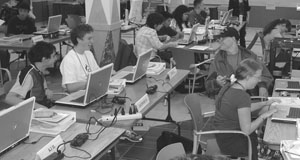
DO-IT Scholars are given many opportunities to learn and practice self-determination skills. For example, DO-IT Scholars practice asking for accommodations by role-playing with volunteer faculty. They explore their personal strengths, interests, learning styles, and accommodation needs. When appropriate they learn how to manage personal assistants. They also learn how their roles and responsibilities change as they move from high school to postsecondary institutions to employment settings (Kim-Rupnow & Burgstahler, 2004).
In DO-IT's video series Taking Charge: Stories of Success and Self-Determination and the accompanying handout, students with disabilities share key aspects of leading a self-determined life. These products can be obtained from DO-IT or viewed freely online on the Resources page.
Progress of Teens with Disabilities Toward Careers: Project Inputs Leading Students to Critical Junctures
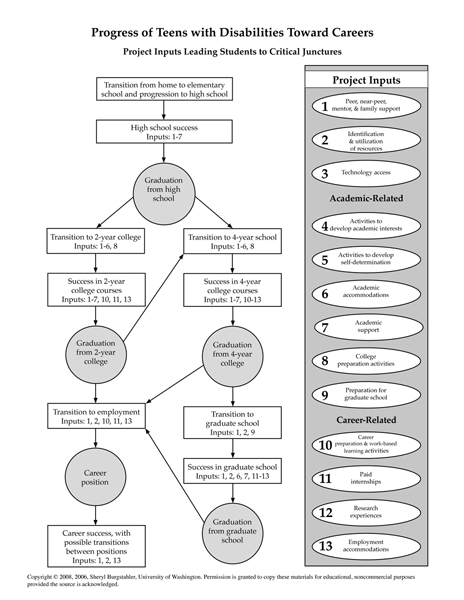
Technology
The use of technology is a necessity in most academic and employment settings. For people with disabilities, technology can level the playing field with peers who do not have disabilities and can facilitate full participation in school and work. Specifically, computers can help students with disabilities complete coursework independently, access distance learning courses; communicate with instructors, mentors, and peers; and participate in high-tech careers (Burgstahler, 2002b). However, people with disabilities face a myriad of challenges in gaining access to technology (Kaye, 2000, National Center for Education Statistics, 2000; National Council on Disability, 2000).
"I plan to go to a four-year college and major in physical therapy." –DO-IT Scholar
DO-IT Scholars are provided with computer equipment, assistive technology (AT), and Internet access in their homes. Scholars are loaned this equipment and software for as long as they are active participants in the program. With the assistance of a technology specialist, Scholars are provided with technology that addresses their specific needs. For example, students who are blind or have disabilities that affect their reading ability may receive speech output systems. Speech input and alternative keyboards are provided for people who do not have full use of their hands.
The following five video presentations, along with publications with the same titles, demonstrate computer technology for students with disabilities. They can be purchased from DO-IT in DVD format or viewed freely online on the Resources page.
- Working Together: People with Disabilities and Computer Technology
- Working Together: Computers and People with Learning Disabilities
- Working Together: Computers and People with Mobility Impairments
- Working Together: Computers and People with Sensory Impairments
- Access to Technology in the Workplace: In Our Own Words
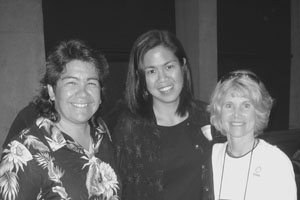
Mentoring and Peer Support
Mentors can provide important and valuable relationships for youth with disabilities (Hawken, Duran, & Kelly, 1991; Stainback, Stainback, & Wilkinson, 1992). Due at least in part to a shortage of available adult mentors, group mentoring programs have emerged. Typically, in this model, one mentor is assigned to a small group of young people, or several mentors work with a group of protégés. In group mentoring situations, positive outcomes can be achieved as a result of peer interactions, in addition to those between mentors and protégés (Byers-Lang & McCall, 1993; Kram & Isabella, 1985). Participants in group mentoring report improvements in social skills, relationships with individuals outside of the group, academic performance, and attitudes (Herrera, Vang, & Gale, 2002; Sipe & Roder, 1999).
In-person mentor, peer, and near-peer relationships can be limited by physical distance, time, and schedule constraints and, in some cases, disability-related communication barriers (e.g., speech impairments). Computer-mediated communication (CMC) does not impose these constraints. The lack of social distinctions like gender, age, disability, race, and physical appearance in CMC can promote interaction (Rheingold, 1993). With the development of assistive technology, all individuals, regardless of disability, can participate in CMC. E-mentoring, online mentoring, or telementoring refer to situations where mentoring occurs via CMC (Wighton, 1993).
"After high school I would like to go to college to study law." –DO-IT Scholar
Group discussions in an e-mentoring community can occur via email, a bulletin board, a blog, or other forms of online communication. Positive benefits of electronic communication include the following:
- Participants benefit from the experiences of a large group of mentors, peers, and near-peers.
- Mentors can specialize in areas where their expertise is strongest.
- The program can perform successfully even when some mentors are less skilled than others.
- The mode of communication does not erect barriers imposed by location, schedule, and disability.
- The program administrator can view all group conversations and thereby more easily manage the mentoring forum. (Burgstahler & Cronheim, 2001)
DO-IT has demonstrated that peer and mentor support, traditionally provided in person, can be delivered within a supported electronic community (Burgstahler, 1997; Burgstahler & Cronheim, 2001). Such support plays an important role in the preparation of Scholars for college and careers (Burgstahler, 1997; Burgstahler & Cronheim, 2001; Kim-Rupnow & Burgstahler, 2004). DO-IT Scholars use electronic communications to connect with peers and adult mentors, most of whom have disabilities themselves. DO-IT staff and mentors pose discussion questions to the online community via electronic mail and share information about schools, internships, and resources. Smaller electronic groups focus on access issues and challenges for specific types of disabilities. From mentors, students learn about career options, how to be more independent and advocate for themselves, and to persevere. Peers provide similar supports in addition to friendship and a sense of belonging. Both types of relationships promote self-esteem.
DO-IT videos provide further information on DO-IT's e-mentoring community. The video and publication Opening Doors: Mentoring on the Internet can be purchased from DO-IT in DVD format or freely viewed online, on the Resources page. The publication and video DO-IT Pals: An Internet Community shares the student perspective regarding peer and mentor support.
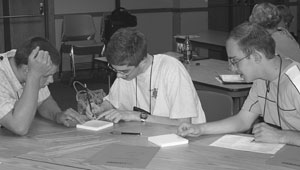
College Preparation Activities
Participation in college preparation programs can help students complete an application, prepare for entrance exams, explore majors, obtain disability-related accommodations, and secure financial aid. Involvement in such activities is associated with a higher likelihood of college enrollment for students with diverse characteristics and backgrounds (Cunningham, Redmond, & Merisotis, 2003).
DO-IT helps students explore challenging fields of study and prepares them for transitions from high school to postsecondary environments. DO-IT Scholars attend Summer Study for two consecutive summers at the University of Washington. They learn how to navigate a large campus, request disability-related accommodations, get along with roommates, and succeed in college courses. One DO-IT Scholar summarized the program's impact this way: "It showed me that I really can succeed in a college setting."
Students who participate in college preparation activities through DO-IT perceive meaningful changes in their level of preparation and skills in these areas (Kim-Rupnow & Burgstahler, 2004). Scholars report developing social, academic, and self-determination skills that lead to success in academics, employment, and adult life. They also become more aware of the challenges other students face as the Scholars work with peers who have a wide variety of disabilities, including sensory impairments, mobility impairments, learning disabilities, health impairments, and psychiatric impairments. For example, in a science lab, it is not unusual to find a student with a visual impairment working with someone without functional use of his hands to perform bypass "surgery" on a sheep heart. They learn quickly to use their combined abilities to complete the lab assignment. An increased awareness of diversity and the abilities, challenges, and accommodation needs of others prepares participants for leadership roles in adult life.
DO-IT does not end on the last day of the on-campus program. Year-round, online communication enhances the value of Summer Study activities and helps students stay in contact with peers, mentors, and staff. As soon as Scholars return home from Summer Study, they log on to the Internet to continue their friendships and receive support from DO-IT staff and mentors. "It's kind of like going to summer camp," reports one Scholar, "but to a certain extent I don't ever have to go home."
The video and publication titled College: You Can DO-IT! can be used to help teens prepare for college. The video can be purchased from DO-IT in DVD format. It can also be freely viewed online at on the Resources page.
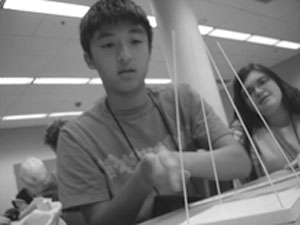
Career Preparation Activities
Career exploration and work-based learning experiences can help students build real-world, job-related skills, as well as integrate and apply academic learning (Benz, Yovanoff, & Doren, 1997; Phelps & Hanley-Maxwell, 1997). The likelihood of future employment is higher for students with disabilities who are involved in some kind of work experience while in high school than it is for those who are not (Stodden & Dowrick, 2000).
During Summer Study, DO-IT Scholars begin to explore career fields. Students have opportunities to develop résumé writing, problem-solving, and interviewing skills as well as apply academic, vocational, interpersonal, and computer skills to work situations. Students also practice disclosing their disabilities in mock interviews, as well as negotiating and testing the effectiveness of specific accommodations in job settings. Participants in DO-IT's work-based learning offerings report that these experiences help prepare them for careers (Burgstahler, 2001; Burgstahler, Lopez, & Bellman, 2004).
Additionally, DO-IT participants are supported in applying for and participating in internships. After completing two years of DO-IT's Summer Study, Scholars have the option to return to Summer Study as interns. They help with the work that goes on behind the scenes and share their experiences with younger participants. Opportunities to participate in paid internships on college campuses, in government agencies, and in high-tech companies are also available through DO-IT.
Two videos and accompanying handouts, Learn and Earn: Tips for Teens and Learn and Earn: Supporting Teens, help students and staff, respectively, understand the value of work-based learning. They can be purchased in DVD format from DO-IT or freely viewed online on the Resources page.
Conclusion
DO-IT Scholars and parents report that participation in DO-IT programs has had a positive impact on academic and career outcomes. DO-IT program participants report significant short-term and long-term growth in their level of preparation for college and employment and increased development of self-advocacy and social skills (Burgstahler, 2002c; Burgstahler, 2003a; Kim-Rupnow & Burgstahler, 2004). Data provide evidence that DO-IT's Summer Study, work-based learning opportunities, and year-round peer and mentor support improve the social, academic, and career skills of students with disabilities (Kim-Rupnow & Burgstahler). They have a positive impact on postsecondary academic and career outcomes for people with disabilities.
DO-IT applies evidence-based practices to increase the number of people successful in challenging college and career fields such as science, technology, engineering, and mathematics. Ultimately, project outcomes will benefit society by increasing participation in these fields and by enhancing these fields with the perspectives of people with disabilities. These efforts support the goals proposed in recent reports from the Committee on Prospering in the Global Economy of the 21st Century (2006), the Office of Science and Technology Policy (2006), and the National Science Foundation (2006).
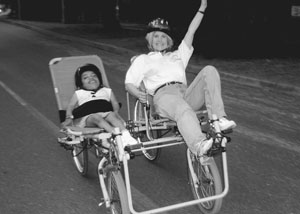
How to Download or Purchase This Book
It might be helpful for you to have electronic copies of forms and other content for modification and application in your setting. The most current electronic copy of these materials can be found at Creating a Transition Program for Teens: How DO-IT does it, and how you can do it, too. Videos that complement the content of this book can also be found there for free online viewing; trainers can freely download copies of videos to project from their own computers by directing requests to doit@u.washington.edu. Other DO-IT videos can be viewed online on the Video page.
Copies of the printed book and videos can also be purchased from DO-IT. Details can be found on the Resources page.
What's Next
The remaining sections of this book describe how DO-IT's evidence-based program components and comprehensive strategies are applied to the DO-IT Scholars program. We highlight key considerations to help you get started in developing programs that include computer technology access, peer and mentor support, college preparation activities, and/or work-based learning. Appendices include forms and other documents that can be tailored to specific programs. Please note that inclusion of content or forms in this book does not mean endorsement for use in other programs. Administrators should research federal, state, and local laws and policies, as well as policies and procedures at their sponsoring institutions, as they develop appropriate procedures for their programs.